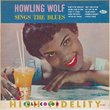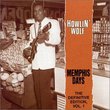| All Artists: Howlin Wolf Title: Memphis Days V.2 Members Wishing: 2 Total Copies: 0 Label: Bear Family Original Release Date: 1/1/1999 Re-Release Date: 7/27/1996 Album Type: Import Genre: Blues Styles: Chicago Blues, Traditional Blues, Regional Blues, Memphis Blues, Electric Blues Number of Discs: 1 SwapaCD Credits: 1 |
Search - Howlin Wolf :: Memphis Days V.2
 | Howlin Wolf Memphis Days V.2 Genre: Blues
Second volume collection of his early recordings produced by the legendary Sam Phillips at the famed Sun Studio in Memphis, Tennessee. The deluxe booklet includes extensive liner notes by Jim Dickinson, and a discography ... more » |
Larger Image |
CD DetailsSynopsis
Album Description Second volume collection of his early recordings produced by the legendary Sam Phillips at the famed Sun Studio in Memphis, Tennessee. The deluxe booklet includes extensive liner notes by Jim Dickinson, and a discography of his 1951-1952 Memphis recordings by Dave Sax. A must have for any Wolf fan. Similar CDs
|
CD ReviewsJust buy it. Lee Hartsfeld | Central Ohio, United States | 11/23/2001 (5 out of 5 stars) "Howlin' Wolf's earliest, pre-Chicago material was his best, by far, and this CD proves it. All of these tracks were recorded at Sun Studios, and they feature powerful and brilliantly minimalist blues music unlike the more assembly-line Chicago stuff that has been allowed to epitomize the genre. In a perfect universe, Wolf would have made ten times this many records while in Memphis, and each and every master tape would have survived intact. That didn't happen in our universe, but let's be thankful for the Early Wolf that HAS survived. Savor Willie Johnson's distorted guitar, particularly the nimble runs on "The Wolf is at your door" and the economic but dazzling genius of his lead work on "Howlin' Wolf boogie," the intro to which I haven't yet recovered from. And, lest anyone doubt that rock and roll existed long before it had a name, behold Johnson's amp-busting power chords on 1951's "How many more years," a track that renews itself every one hundred listenings or so. Wolf's voice is allowed full reign on these recordings, possibly because, at Sun, Wolf was allowed to play what he wanted to play without endless interruptions and Leonard-Chess-style admonitions of "Keep it simple." At Sun, Wolf was playing the actual music, not someone's hackneyed notion of what it was supposed to sound like. You might prefer these early sides. Or you might like them as much as the later material, or not as much. No matter. Just buy it."
|

 Track Listings (19) - Disc #1
Track Listings (19) - Disc #1

